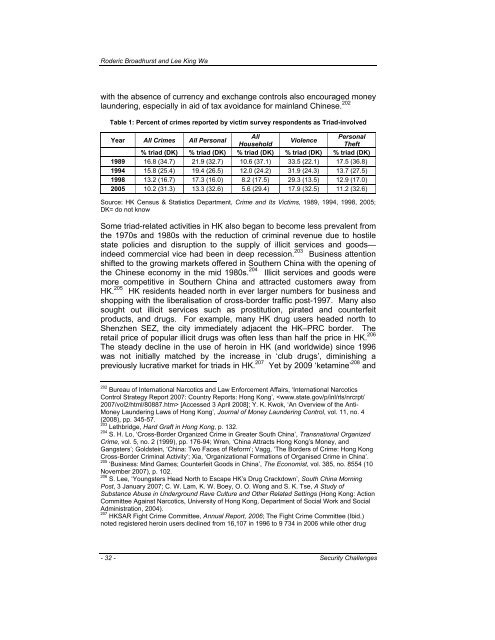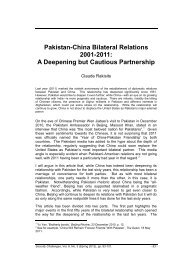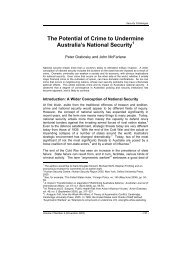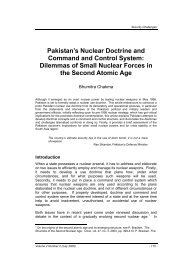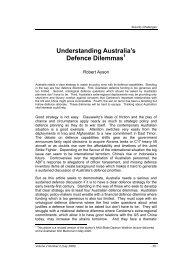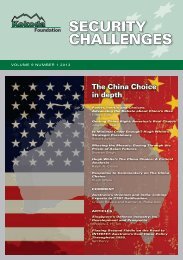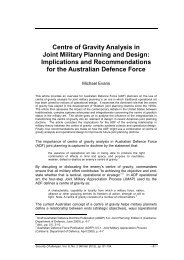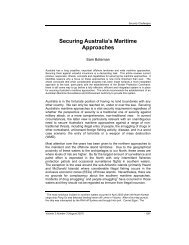The Transformation of Triad - Security Challenges
The Transformation of Triad - Security Challenges
The Transformation of Triad - Security Challenges
You also want an ePaper? Increase the reach of your titles
YUMPU automatically turns print PDFs into web optimized ePapers that Google loves.
Roderic Broadhurst and Lee King Wa<br />
with the absence <strong>of</strong> currency and exchange controls also encouraged money<br />
laundering, especially in aid <strong>of</strong> tax avoidance for mainland Chinese. 202<br />
Table 1: Percent <strong>of</strong> crimes reported by victim survey respondents as <strong>Triad</strong>-involved<br />
Year All Crimes All Personal<br />
All<br />
Household<br />
Violence<br />
Personal<br />
<strong>The</strong>ft<br />
% triad (DK) % triad (DK) % triad (DK) % triad (DK) % triad (DK)<br />
1989 16.8 (34.7) 21.9 (32.7) 10.6 (37.1) 33.5 (22.1) 17.5 (36.8)<br />
1994 15.8 (25.4) 19.4 (26.5) 12.0 (24.2) 31.9 (24.3) 13.7 (27.5)<br />
1998 13.2 (16.7) 17.3 (16.0) 8.2 (17.5) 29.3 (13.5) 12.9 (17.0)<br />
2005 10.2 (31.3) 13.3 (32.6) 5.6 (29.4) 17.9 (32.5) 11.2 (32.6)<br />
Source: HK Census & Statistics Department, Crime and Its Victims, 1989, 1994, 1998, 2005;<br />
DK= do not know<br />
Some triad-related activities in HK also began to become less prevalent from<br />
the 1970s and 1980s with the reduction <strong>of</strong> criminal revenue due to hostile<br />
state policies and disruption to the supply <strong>of</strong> illicit services and goods—<br />
indeed commercial vice had been in deep recession. 203 Business attention<br />
shifted to the growing markets <strong>of</strong>fered in Southern China with the opening <strong>of</strong><br />
the Chinese economy in the mid 1980s. 204 Illicit services and goods were<br />
more competitive in Southern China and attracted customers away from<br />
HK. 205 HK residents headed north in ever larger numbers for business and<br />
shopping with the liberalisation <strong>of</strong> cross-border traffic post-1997. Many also<br />
sought out illicit services such as prostitution, pirated and counterfeit<br />
products, and drugs. For example, many HK drug users headed north to<br />
Shenzhen SEZ, the city immediately adjacent the HK–PRC border. <strong>The</strong><br />
retail price <strong>of</strong> popular illicit drugs was <strong>of</strong>ten less than half the price in HK. 206<br />
<strong>The</strong> steady decline in the use <strong>of</strong> heroin in HK (and worldwide) since 1996<br />
was not initially matched by the increase in ‘club drugs’, diminishing a<br />
previously lucrative market for triads in HK. 207 Yet by 2009 ‘ketamine’ 208 and<br />
202<br />
Bureau <strong>of</strong> International Narcotics and Law Enforcement Affairs, ‘International Narcotics<br />
Control Strategy Report 2007: Country Reports: Hong Kong’, [Accessed 3 April 2008]; Y. K. Kwok, ‘An Overview <strong>of</strong> the Anti-<br />
Money Laundering Laws <strong>of</strong> Hong Kong’, Journal <strong>of</strong> Money Laundering Control, vol. 11, no. 4<br />
(2008), pp. 345-57.<br />
203<br />
Lethbridge, Hard Graft in Hong Kong, p. 132.<br />
204<br />
S. H. Lo, ‘Cross-Border Organized Crime in Greater South China’, Transnational Organized<br />
Crime, vol. 5, no. 2 (1999), pp. 176-94; Wren, ‘China Attracts Hong Kong’s Money, and<br />
Gangsters’; Goldstein, ‘China: Two Faces <strong>of</strong> Reform’; Vagg, ‘<strong>The</strong> Borders <strong>of</strong> Crime: Hong Kong<br />
Cross-Border Criminal Activity’; Xia, ‘Organizational Formations <strong>of</strong> Organised Crime in China’.<br />
205<br />
‘Business: Mind Games; Counterfeit Goods in China’, <strong>The</strong> Economist, vol. 385, no. 8554 (10<br />
November 2007), p. 102.<br />
206<br />
S. Lee, ‘Youngsters Head North to Escape HK’s Drug Crackdown’, South China Morning<br />
Post, 3 January 2007; C. W. Lam, K. W. Boey, O. O. Wong and S. K. Tse, A Study <strong>of</strong><br />
Substance Abuse in Underground Rave Culture and Other Related Settings (Hong Kong: Action<br />
Committee Against Narcotics, University <strong>of</strong> Hong Kong, Department <strong>of</strong> Social Work and Social<br />
Administration, 2004).<br />
207<br />
HKSAR Fight Crime Committee, Annual Report, 2006; <strong>The</strong> Fight Crime Committee (Ibid.)<br />
noted registered heroin users declined from 16,107 in 1996 to 9 734 in 2006 while other drug<br />
- 32 - <strong>Security</strong> <strong>Challenges</strong>


